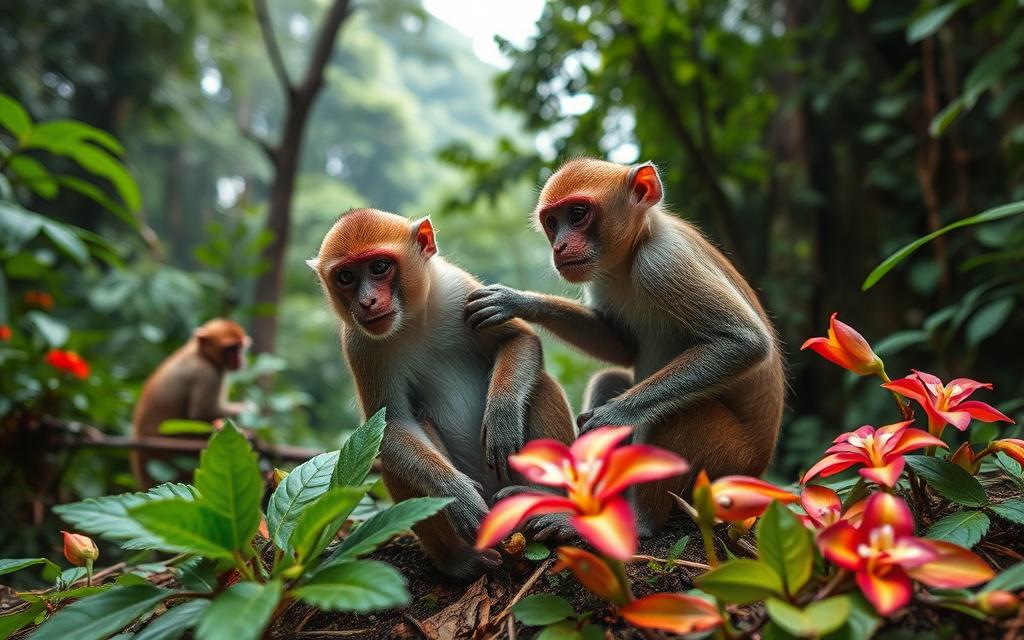
Sacred Monkey Forest Santuary: Environmental Impact Explored
Ghana loses over 65,000 hectares of forest each year, making it a big problem in West Africa1. This shows how urgent it is to protect our planet. The Sacred Monkey Forest in Ubud, Bali, is a key place for this2. It shows how tourism and nature can work together.
This place is not just a home for animals. It teaches us how to travel without harming the environment. By visiting, we help protect many species and their homes.
Key Takeaways
- The Sacred Monkey Forest is crucial for ecological conservation in Bali.
- Ghana’s high deforestation rate serves as a global warning.
- Responsible tourism practices are vital for preserving natural habitats.
- Engagement with local communities enhances conservation efforts.
- The Sanctuary balances tourism needs with environmental sustainability.
Introduction to Sacred Monkey Forest
The Sacred Monkey Forest, also known as the Ubud Monkey Forest, is a special place in Bali. It covers about 30.8 acres and is home to around 600 long-tailed macaques. This makes it a key spot for both nature lovers and tourists3. Ubud is the heart of Bali’s culture, showing off the island’s traditions and beauty4.
People visit the Sacred Monkey Forest to see the monkeys up close and enjoy the beautiful nature and old temples. The forest’s history is deep, with temples that are nearly 700 years old. It teaches the balance between humans, nature, and the divine4.
At the entrance, you can buy bananas and snacks from local vendors. This lets you interact with the monkeys in a safe way. Signs throughout the forest help visitors behave respectfully, making sure everyone has a good time while protecting the environment4.
Historical Significance of the Sacred Monkey Forest
The Sacred Monkey Forest is full of historical significance. It shows the deep connection between Balinese culture and nature. Since the 14th century, it has been a place where humans and nature live together.
It is home to about 700 Balinese long-tailed macaques. This makes it one of the biggest places for these monkeys in Bali5.
The forest has temples for different gods, like Lord Shiva. This shows how nature and spirituality are connected. In the 20th century, it became a key place for conservation.
Now, it helps protect many species and supports eco-tourism. Feeding the monkeys is not allowed to keep them healthy5.
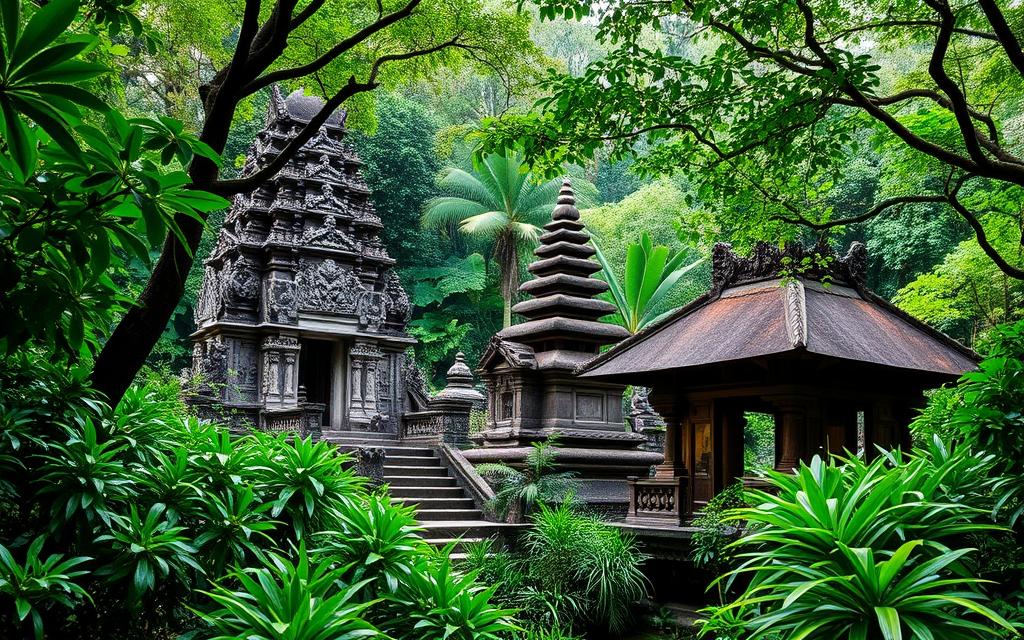
Guided tours teach visitors about the forest’s history and its role in conservation. By paying to visit and giving donations, tourists help protect the forest. This supports education and conservation efforts5.
The forest is very important in Balinese culture. It shows the deep connection between nature, people, and tradition6.
The Sacred Monkey Forest shows how humans, animals, and culture are connected. It’s a place that we must keep safe for the future.
Tri Hita Karana: The Philosophy Behind Conservation
Tri Hita Karana is key to the Sacred Monkey Forest Sanctuary’s conservation efforts. It teaches us to live in harmony with nature, the divine, and each other. This philosophy aims for well-being by balancing three main relationships in our lives.
This belief encourages us to love and protect nature. It leads to actions that keep the environment safe. For instance, the Tumpek Kandang ceremony celebrates the forest’s animals and plants. It shows how spirituality and caring for nature go hand in hand.
Studies and community work show how Tri Hita Karana helps protect wildlife. The Sacred Monkey Forest is a place for learning about monkeys and their social lives. It’s a spot where nature and culture meet, making people feel closer to the earth7. The forest is home to 115 tree species, showing how Tri Hita Karana supports nature’s diversity7.
The sanctuary is a perfect example of how to protect nature and culture together. By following Tri Hita Karana, we work to keep the environment and traditions safe for the future. This way, we honor our deep connection with nature7.
Ecological Importance of the Forest
The Sacred Monkey Forest Sanctuary is very important for nature. It has many plants and protects important places for monkeys. This place has lots of tree types, making a healthy environment for all living things.
Tree Species Diversity
There are over 115 tree types in the sanctuary. Each tree helps make the place full of life. They are also important in Balinese culture, used in rituals and traditions. Keeping these trees safe is key to keeping the ecosystem balanced and healthy8.
Primate Habitat Protection
The sanctuary is a key place for long-tailed macaques. It shows how important it is to protect their homes. By taking care of the monkeys, the sanctuary helps keep the forest healthy. This shows how important it is for the environment9.
Sustainable Tourism Practices at the Sanctuary
Sustainable tourism is key to keeping the Sacred Monkey Forest safe. The sanctuary has rules for visitors. These rules help guests and nature live together peacefully. They make sure your visit helps the community and doesn’t harm the environment.
Visitor Guidelines and Respect for Sacred Grounds
The rules at the Monkey Forest make your visit better and protect the sacred place. You should:
- Dress modestly to honor the site’s culture.
- Not feed the monkeys to keep them healthy and natural.
- Stay on paths to protect the forest, following sustainable tourism.
- Keep quiet to not disturb the peaceful place.
These steps make your visit better and help protect the area. They keep the place special for everyone.
Community Engagement in Conservation Efforts
The local people help with conservation, working together for sustainable tourism. They join in rituals and help manage the sanctuary. This makes them proud to protect their home.
Educational programs teach both locals and visitors why it’s important to protect nature. This helps everyone understand the value of sustainable tourism.
By joining in, you help a big effort to support sustainability. This makes your visit more meaningful and helps the environment.
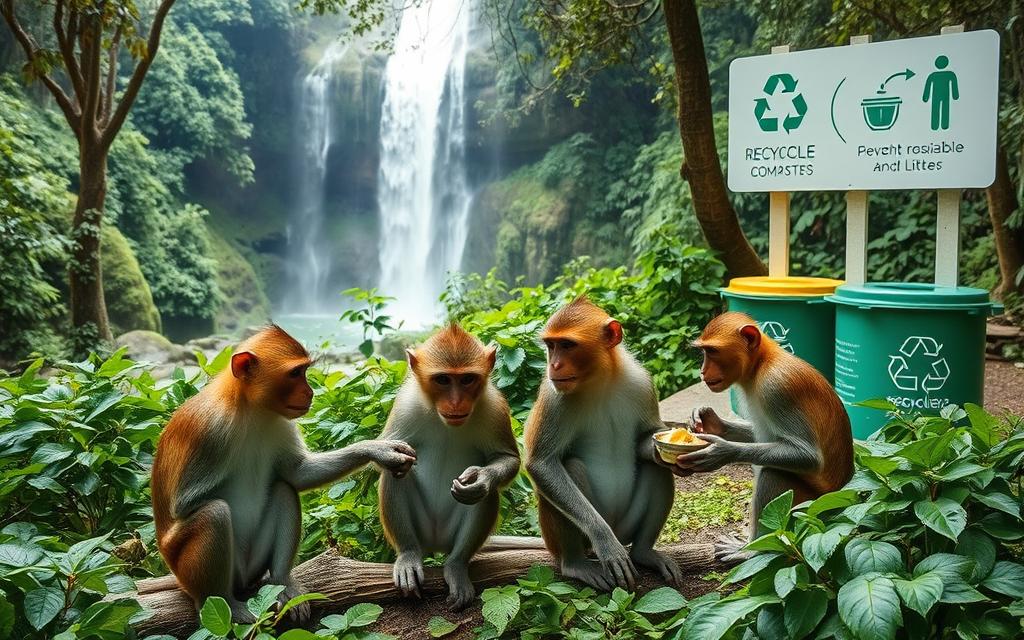
Environmental Impact of Deforestation
Deforestation greatly harms ecosystems, like the Sacred Monkey Forest. Between 1992 and 2018, 242.19 hectares of closed forest were lost10. Even though open forest areas grew by 122.85 hectares, the loss of homes for many species, including monkeys, is big10.
Oil palm plantations are a big reason for deforestation and losing species, as shown in a 2016 study11. This issue is hard to solve because it breaks up animal homes into small pieces. This hurts the genetic diversity of endangered primates, like the pied tamarins and northern muriquis11.
We need everyone to help protect the forest. By learning more about deforestation, we can all do our part. This will help keep the forest and its animals safe.
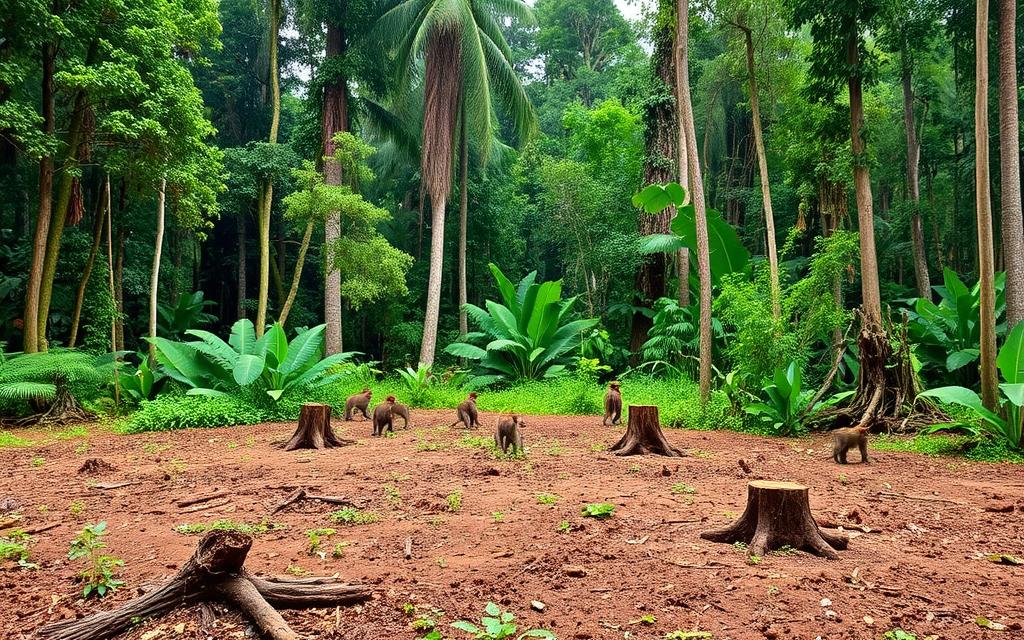
Projected Environmental Benefits of Responsible Travel
When you travel responsibly, you help the planet in big ways. You protect important places and help local communities. This is more important as more people want to travel.
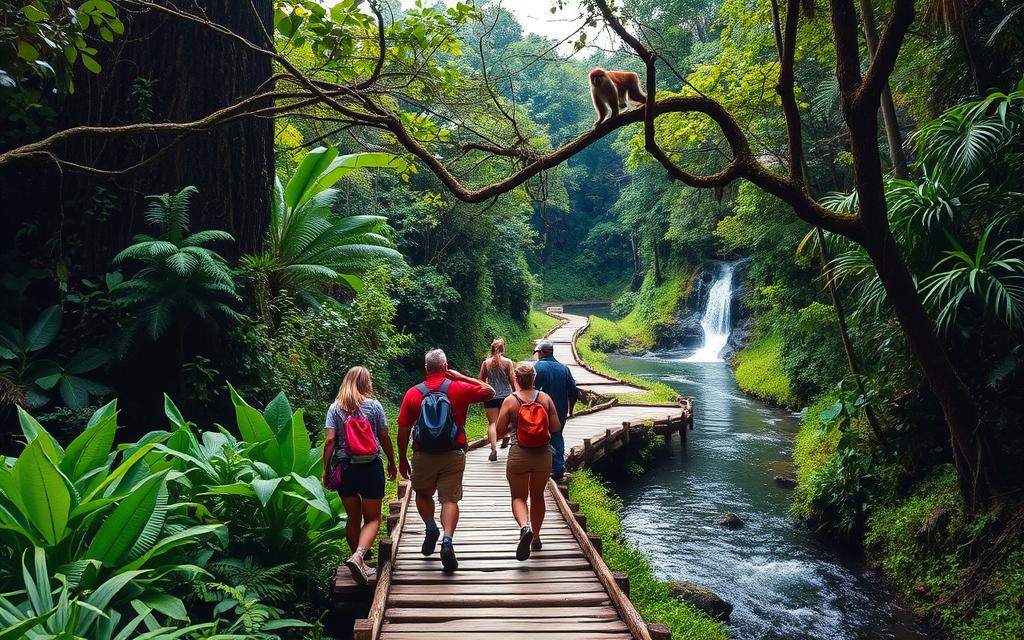
More people now want to travel in a green way. They think about how their trips affect the planet12. They look for ways to lessen harm to the environment and support local economies12.
Using green travel can save money too. It cuts down on things like energy bills and fuel costs12.
- Choosing where to travel wisely helps protect nature and culture.
- Supporting local shops and fair pay for workers helps communities.
- Choosing green travel options lowers your carbon footprint.
Sticking to sustainable travel has big benefits. You get to explore and help protect nature. This can make people more aware of the need to protect the environment.
Your travel choices can make a big difference. They show the world the importance of caring for our planet. By choosing to travel responsibly, you help make the future healthier12.
Exploring the Role of Ecotourism
Visiting the Sacred Monkey Forest helps protect the environment and save nature. It lets people help reduce carbon emissions and save different species. By joining in, visitors help make a big difference.
Carbon Footprint Reduction Initiatives
Ecotourism at the sanctuary works to lessen the harm from tourism. It uses green transport and smart waste handling to teach visitors to be eco-friendly. Working with local people, the forest teaches the importance of living sustainably.
This helps keep the ecosystem healthy. The sanctuary is a leader in reducing carbon emissions and helping the planet.
Biodiversity Preservation Strategies
The Sacred Monkey Forest is dedicated to saving many species and their homes. It has programs to protect native animals and fix their habitats. Teaching the community about nature’s importance is also key.
Ecotourism is a big help. It spreads the word and raises money for saving the forest. This way, everyone can help take care of the forest together.
Sacred Monkey Forest and Environmental Impact
The Sacred Monkey Forest Sanctuary shows how tourism and conservation can work together. It’s home to about 1,000 monkeys and deals with too many monkeys. This needs careful planning to keep nature in balance13. The local government, groups, and leaders work together for sustainable tourism13.
They focus on controlling the monkey population by sterilizing and vaccinating them. This stops rabies and slows down growth14. Now, they’re also vaccinating dogs to protect wildlife and people14. Their goal is to stop all rabies cases by 202814.
Eco-tourism is meant to help nature, but it can harm the environment and spread diseases13. It’s important to find a balance. By being a responsible tourist, you help the sanctuary and the environment.
Conclusion
The Sacred Monkey Forest Sanctuary is a key place for nature and culture. It teaches us the importance of caring for our planet through tourism. By visiting, you help protect nature and follow the Tri Hita Karana philosophy. This means you care about keeping the earth safe for the future.
When you connect with the local culture and animals, you learn to value nature’s balance. This knowledge helps you support efforts to keep the macaques and their homes safe. Studies show that human actions affect these animals a lot1516.
The Sacred Monkey Forest shows us the beauty of nature and the need to protect it. By choosing to visit wisely, you help keep this place safe. Let’s work together to protect these amazing places for the future.
FAQ
What is the Sacred Monkey Forest Sanctuary?
The Sacred Monkey Forest Sanctuary, also known as the Ubud Monkey Forest, is a key place in Bali. It’s home to about 600 long-tailed macaques. It’s both a cultural and natural treasure, supporting sustainable tourism and protecting the environment.
How does the sanctuary contribute to environmental conservation?
The sanctuary has strict rules for visitors to protect wildlife and nature. It works with the local community on conservation, helping to keep biodiversity high and promoting green practices.
What is the philosophy of Tri Hita Karana?
Tri Hita Karana means “Three Causes of Well-being.” It’s all about finding balance between people, nature, and the spiritual world. This idea guides the sanctuary’s work in protecting nature and teaches visitors and locals about caring for the earth.
Why is biodiversity important in the Sacred Monkey Forest?
Biodiversity keeps the ecosystem healthy. The forest is home to 115 tree species, some important to the culture, and protects the long-tailed macaques. This balance is key to the forest’s health and cultural heritage.
What visitor guidelines should I follow when visiting the sanctuary?
Dress modestly and respect sacred places. Avoid actions that bother the monkeys or their home. These rules help keep the forest sacred and safe for all.
How does deforestation affect the Sacred Monkey Forest?
Deforestation is a big threat to the forest’s life. It can make animals like the long-tailed macaques lose their homes, which is bad for the forest’s health.
What can I do to promote responsible travel when visiting the sanctuary?
Choose green travel options and be eco-friendly. Use public transport and reduce waste. This helps lower your carbon footprint and supports local conservation and the economy.
What initiatives are in place for carbon footprint reduction at the sanctuary?
The sanctuary encourages using eco-friendly transport and good waste management. By joining in, you help make a positive impact on the environment.
How does community engagement enhance conservation efforts?
Getting local communities involved in tourism and conservation builds a sense of pride and responsibility. This is key for protecting the habitat and its animals for a long time.
Can visiting the Sacred Monkey Forest make a difference?
Yes! Your visit can help with conservation and protecting nature. Just follow the rules, respect the culture, and learn why it’s important to protect these places.
Source Links
- https://www.macrothink.org/journal/index.php/jee/article/download/19836/15353
- https://feastoftravel.com/monkey-forest-ubud/
- https://www.chrie.org/assets/docs/JHTC-case-notes/JHTC-vol-7/JHTC_Vol7Issue3-Bragg_case.pdf
- https://medium.com/mginative/planet-of-the-balinese-monkeys-a20ee6dc14b9
- https://balicheapesttours.com/ubud-monkey-forest.html
- https://theltmproject.org/wp-content/uploads/2022/04/natural-cultural-encounters-in-bali_-monkeys-temples-tourists-and-ethnoprimatology.pdf
- https://monkeyforestubud.com/about-us/
- https://e360.yale.edu/features/sacred-groves-religion-forests
- https://www.cambridge.org/core/journals/environmental-conservation/article/sacred-forests-of-india-a-strong-tradition-of-communitybased-natural-resource-management/3401ADC3D9FCB79602E599BBDFF4A108
- https://orca.cardiff.ac.uk/id/eprint/145082/1/1-s2.0-S2351989420309823-main.pdf
- https://www.ncbi.nlm.nih.gov/pmc/articles/PMC5242557/
- https://rezdy.com/blog/sustainable-tourism-what-it-is-how-tour-operators-can-help/
- https://www.classace.io/answers/write-an-essay-about-case-study-1-wildlife-tourism-as-a-form-of-ecotourism-wildlife-tourism-as-a-form-of-ecotourism-the-case-of-the-sacred-monkey-forest-sanctuary-of-ubud-bal-based-your-answer-with-wh
- https://thebalisun.com/efforts-to-protect-tourists-at-balis-famous-monkey-forests-are-intensifying/
- https://www.cambridge.org/core/journals/oryx/article/complexities-of-local-cultural-protection-in-conservation-the-case-of-an-endangered-african-primate-and-forest-groves-protected-by-social-taboos/88CD0EF04A65E6A226603F44D978A52D
- https://www.ncbi.nlm.nih.gov/pmc/articles/PMC10777948/